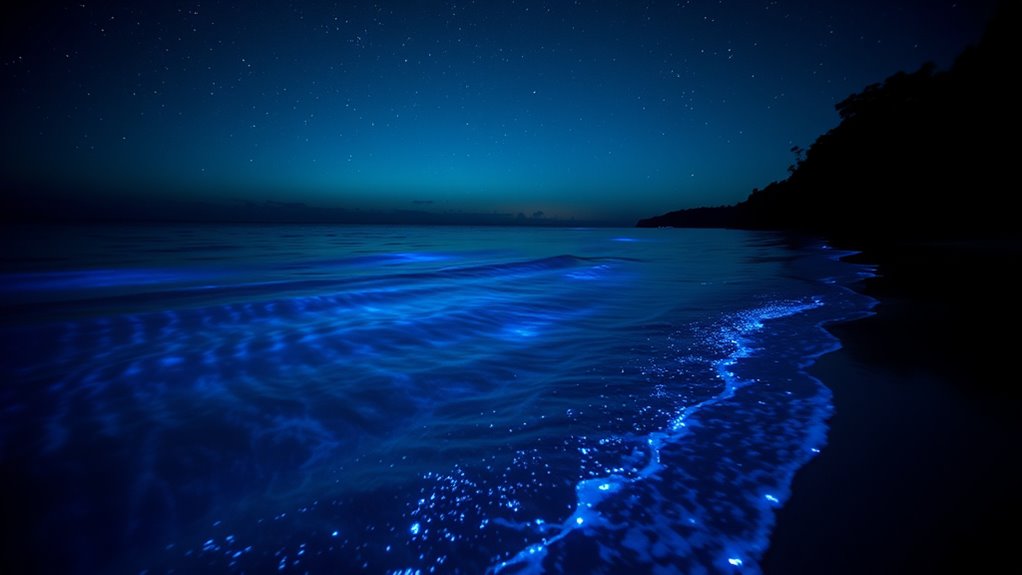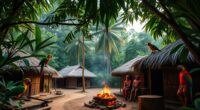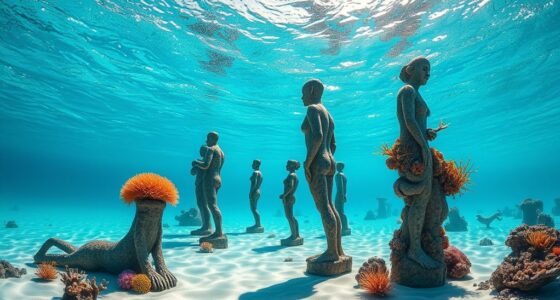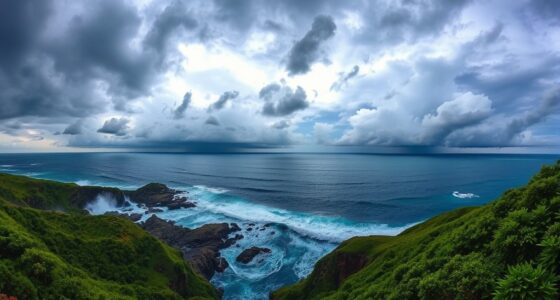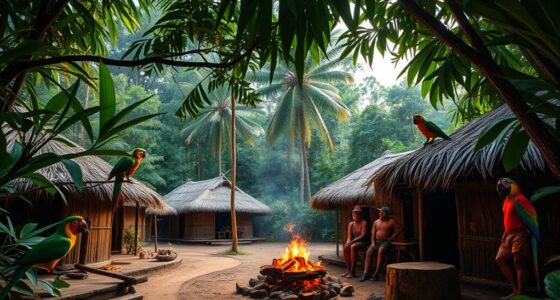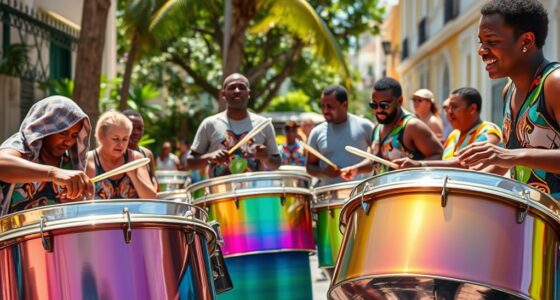In Puerto Rico’s bioluminescent bays, tiny microorganisms called dinoflagellates produce a natural glow through a chemical reaction involving luciferin and luciferase enzymes. When you disturb the water, like paddling in a kayak, these microorganisms emit sparkling light. This breathtaking display is a sign of a healthy, vibrant ecosystem. Curious to find out what makes this phenomenon truly special and how it supports the environment? Keep exploring to discover more secrets behind this natural marvel.
Key Takeaways
- Bioluminescent bays glow due to dinoflagellates, microscopic microorganisms that emit light through a chemical reaction involving luciferin and luciferase.
- Movement, such as water disturbance or paddling, triggers the microorganisms’ glowing response in the water.
- The bioluminescence indicates a healthy ecosystem where these microorganisms thrive and play a vital ecological role.
- The phenomenon showcases natural chemical processes that produce visible light, creating mesmerizing visual displays at night.
- Conservation efforts are crucial to preserve the delicate balance of these ecosystems and their unique bioluminescent properties.
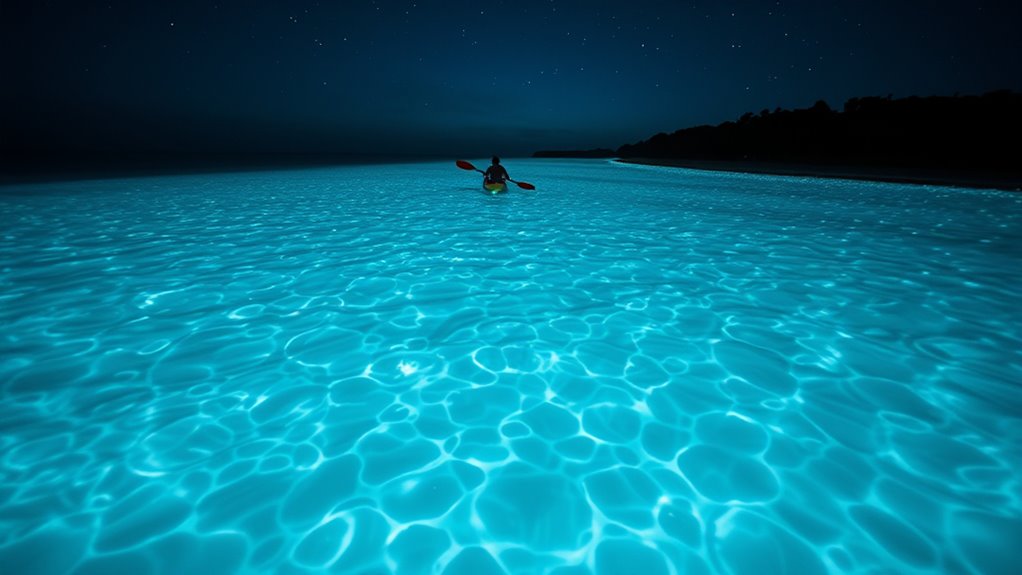
Puerto Rico is home to some of the world’s most stunning bioluminescent bays, where the water glows with an otherworldly light at night. These natural wonders are not only breathtaking sights but also essential parts of marine ecology, offering unique ecosystems that thrive in their specific conditions. When you visit these bays, you’re stepping into environments teeming with microscopic organisms called dinoflagellates, which produce the mesmerizing glow. Understanding the science behind this phenomenon enriches your experience, revealing how delicate and interconnected these ecosystems are. The bioluminescence occurs when these microorganisms are disturbed—every splash, paddle stroke, or movement in the water causes a sparkling reaction. This natural light display is a result of a chemical reaction involving luciferin and luciferase enzymes within the dinoflagellates, which emit light as a defense mechanism or a way to attract mates.
Puerto Rico’s bioluminescent bays glow at night due to microscopic dinoflagellates reacting to disturbance.
As a tourist, you’ll find these bays to be among the most popular tourist attractions in Puerto Rico. Tour operators offer guided kayak or boat tours at night, allowing you to witness the glowing waters firsthand. These experiences are not only visually stunning but also educational, providing insights into the ecological importance of the bioluminescent microorganisms. Visiting the bays, especially Mosquito Bay in Vieques, Laguna Grande in Fajardo, or La Parguera in Lajas, becomes a memorable adventure that combines natural beauty with ecological awareness. These sites draw visitors from around the world, enthusiastic to see the glow and learn about the fragile ecosystems that support it.
The attraction of these bays extends beyond their visual appeal. They serve as living laboratories for marine ecology, helping scientists study the interactions between microorganisms, water chemistry, and environmental health. Protecting these ecosystems is essential because pollution, climate change, and human activity threaten their delicate balance. As a visitor, you can contribute to conservation efforts by following guidelines that minimize disturbance—such as avoiding the use of flashlights or loud noises that can harm the dinoflagellates. The glowing waters are a precious resource, a natural spectacle that also underscores the importance of preserving marine biodiversity.
In essence, Puerto Rico’s bioluminescent bays are a perfect blend of captivating tourist attractions and critical marine ecological systems. They invite you to marvel at nature’s magic while reminding you of the importance of safeguarding these fragile environments for future generations. When you witness the glow, you’ll understand why these bays are truly one of the most extraordinary natural phenomena in the world.
Frequently Asked Questions
How Do Bioluminescent Organisms Reproduce in Puerto Rico’S Bays?
You might wonder how bioluminescent organisms reproduce in these bays. During marine reproduction, these organisms, like dinoflagellates, release eggs and sperm into the water, fertilizing externally. Their lifecycle involves growth, reproduction, and sometimes a resting stage, helping them survive environmental changes. In Puerto Rico’s bays, the stable conditions support their reproduction cycles, ensuring the continuous glow. You can see how their lifecycle sustains their presence and mesmerizing light.
Are There Seasonal Variations in the Brightness of the Bioluminescence?
You might think the glow stays constant, but seasonal fluctuations actually influence bioluminescence brightness. Ironically, moonlight effects often dim the glow, as increased moonlight can wash out the bioluminescent display. During new moon phases, the bays shine brighter, highlighting nature’s subtle dance between darkness and light. So, yes, the glow varies throughout the year, offering a mesmerizing reminder of how natural cycles impact these magical waters.
Can Humans Safely Swim in the Bioluminescent Waters?
You might wonder if it’s safe to swim in glowing plankton, and generally, it is. The bioluminescent algae that create the beautiful glow are harmless to humans. When you swim in these waters, you don’t risk exposure to toxic substances, but you should still avoid disturbing the environment. Remember, enjoying the glow responsibly helps preserve this natural wonder for everyone to experience safely.
What Impact Does Tourism Have on the Bioluminescent Ecosystems?
Tourism can feel like a double-edged sword for delicate ecosystems. While eco-tourism benefits include raising awareness and funding conservation efforts, it can also cause environmental impact if not managed properly. Increased human activity may disturb the bioluminescent organisms, risking damage to their habitat. You play a vital role in minimizing this impact by supporting responsible tourism practices that protect these glowing marvels for generations to come.
How Long Does It Take for the Glow to Fade After an Event?
You might wonder how long the glow lasts after an event. Typically, the glow duration depends on factors like water temperature and nutrient levels. The fading process can take anywhere from a few hours to a couple of days. During this time, the bioluminescent organisms gradually reduce their light emission as they use their energy reserves, returning the bay to its natural, dark state. Proper care helps preserve this mesmerizing phenomenon.
Conclusion
Now that you’ve learned about Puerto Rico’s incredible bioluminescent bays, you can truly appreciate the natural wonder they represent. Their glowing waters aren’t just beautiful—they’re a delicate balance of biology and chemistry. Will you visit these magical bays and witness their glow firsthand, or let the mystery remain only in stories? Either way, understanding the science behind the glow deepens your connection to these extraordinary ecosystems. Isn’t the world more amazing when we understand its secrets?

